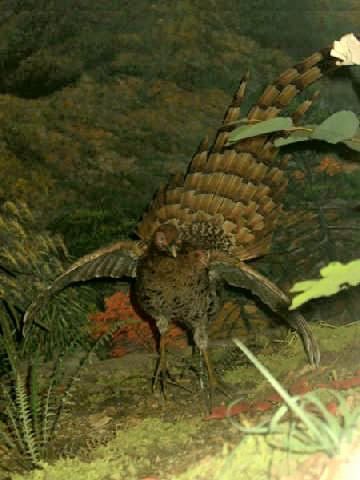Copper Pheasant on:
[Wikipedia]
[Google]
[Amazon]
 The copper pheasant or Soemmerring's pheasant (''Syrmaticus soemmerringii'') is endemic to Japan. The scientific name commemorates the
The copper pheasant or Soemmerring's pheasant (''Syrmaticus soemmerringii'') is endemic to Japan. The scientific name commemorates the
BirdLife Species Factsheet
Red Data Book
{{Taxonbar, from=Q731600 Syrmaticus Endemic birds of Japan Birds described in 1830 Taxa named by Coenraad Jacob Temminck
 The copper pheasant or Soemmerring's pheasant (''Syrmaticus soemmerringii'') is endemic to Japan. The scientific name commemorates the
The copper pheasant or Soemmerring's pheasant (''Syrmaticus soemmerringii'') is endemic to Japan. The scientific name commemorates the German
German(s) may refer to:
* Germany (of or related to)
**Germania (historical use)
* Germans, citizens of Germany, people of German ancestry, or native speakers of the German language
** For citizens of Germany, see also German nationality law
**Ger ...
scientist Samuel Thomas von Sömmerring.
Description
It is a large pheasant with a rich coppery chestnut plumage, yellowishbill
Bill(s) may refer to:
Common meanings
* Banknote, paper cash (especially in the United States)
* Bill (law), a proposed law put before a legislature
* Invoice, commercial document issued by a seller to a buyer
* Bill, a bird or animal's beak
Plac ...
, brown iris and red facial skin. The female is a brown bird with greyish brown upperparts and buff barred dark brown below. The male has short spurs on its grey legs, while the female has none. He measures 87.5–136 cm (34.5–54 in) long including the tail, while the female measures 51–54 cm (20–21 in) (subspecies scintillating copper pheasant, ''scintillans'') including the tail.''Handbook of the Birds of the World
The ''Handbook of the Birds of the World'' (HBW) is a multi-volume series produced by the Spanish publishing house Lynx Edicions in partnership with BirdLife International. It is the first handbook to cover every known living species of bird. T ...
'', Volume 2, Lynx Edicions, Barcelona
Distribution and habitat
The copper pheasant is distributed in and endemic to the hill and mountain forests ofHonshū
, historically called , is the largest and most populous island of Japan. It is located south of Hokkaidō across the Tsugaru Strait, north of Shikoku across the Inland Sea, and northeast of Kyūshū across the Kanmon Straits. The island separa ...
, Kyūshū
is the third-largest island of Japan's five main islands and the most southerly of the four largest islands ( i.e. excluding Okinawa). In the past, it has been known as , and . The historical regional name referred to Kyushu and its surround ...
and Shikoku islands of Japan
Japan ( ja, 日本, or , and formally , ''Nihonkoku'') is an island country in East Asia. It is situated in the northwest Pacific Ocean, and is bordered on the west by the Sea of Japan, while extending from the Sea of Okhotsk in the north ...
, where it is known as . The diet consists mainly of insects, arthropods, roots, leaves and grains. Due to ongoing habitat loss, limited range and overhunting in some areas, the copper pheasant is evaluated as Near Threatened on the IUCN Red List of Threatened Species.
Five subspecies of Copper pheasant are generally recognized, which become progressively darker further south in its distribution:
* ''S. soemmeringii soemmeringii,'' Soemmering's Copper pheasant, the nominate subspecies
In biological classification, subspecies is a rank below species, used for populations that live in different areas and vary in size, shape, or other physical characteristics (morphology), but that can successfully interbreed. Not all species ...
, of northern and central Kyushu. This form is dark reddish overall with an amber sheen to the rump and the tips of the upper-tail coverts.
* ''S. s. ijimae'', the Ijima Copper pheasant, of southeast Kyushu. Similar to ''soemmeringii'', but the male has a white rump.
* ''S. s. scintillans'', the Scintillating Copper pheasant, of northern and central Honshu. The northernmost and palest subspecies, with broad white fringes on it belly and flanks.
* ''S. s. intermedius'', the Shikoku Copper pheasant, of southwest Honshu and Shikoku. Darker than ''scintillans'' but also has white fringes on belly and flanks.
* ''S. s. subrufus'', the Pacific Copper pheasant, of southeast Honshu and southwest Shikoku. Has golden instead of white fringes on the rump and upper-tail coverts.
Cultural mentions
The copper pheasant appears in Japanese poetry as far back as poetry composed by Kakinomoto no Hitomaro in the early 8th century, as compiled in the '' Hyakunin Isshu'':References
External links
BirdLife Species Factsheet
Red Data Book
{{Taxonbar, from=Q731600 Syrmaticus Endemic birds of Japan Birds described in 1830 Taxa named by Coenraad Jacob Temminck